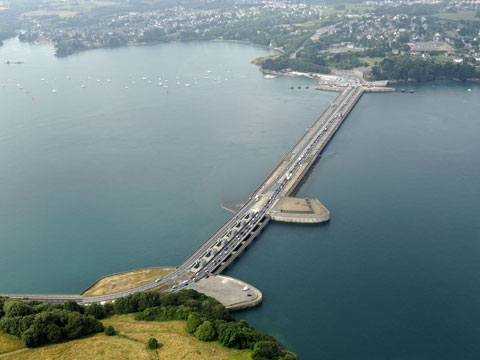

The Rance tidal barrage in North-West France is the largest in the world
Related Articles
- Crisis or rebirth? The future of Ethiopia's pastoralist tribes
- Nuclear waste 'may be blighting 1,000 sites' in the UK
- World Naked Bike Ride: the environmental protest with a difference
- London mayor election: who is the greenest choice?
- Top global brands accused over controversial 'painted home' adverts in Africa
How France eclipsed the UK with Brittany tidal success story
Robert Williams
10th November
The UK may have turned its back on the Severn barrage but across the channel they have been harnessing tidal energy from the River Rance for more than 40 years - and it may yet point to a way forward for smaller-scale renewable projects
Although France is rich in many areas, it is very poor in energy resources. The Germans and Spanish have coal, Britain has enjoyed an abundance of oil, gas and coal, the Dutch have gas from the North Sea, and the Swiss enjoy plentiful hydro-electric power.
French coal mining ended in April 2004 with the closure of the last pit in the Lorraine region. Until the end of the 1970s, French natural gas supplied between six and seven million tons of gas per year, contributing up to 15 per cent of France's primary energy production, but this has now fallen to just 2 per cent, and oil production now stands at less than 1.5 million tons per year.
This lack of indigenous energy resources is, perhaps, a main reason why the French were conscious of the need for energy security long before the term became fashionable. This is also why France's energy policy has given priority to the development of a national, secure network of energy supplies, especially nuclear energy and renewable energies.
The French, as have other nations, have long looked to the power of the sea. French novelist Victor Hugo was very much on the right track when he said, 'Think about the movement of the waves, the ebb and flow, the to-and-fro motion of the tides, the ocean is a vast amount of lost power.'
The sea has actually been harnessed for centuries. Indeed, tidal mills were a medieval invention for milling grain, and were first mentioned as far back as the 12th century in both England and France. They became increasingly common until well into modern times.
These mills were built in low-lying areas, close to the sea. Dams containing swinging gates were built along shallow creeks. As the tide came in, the gates swung open inward, away from the sea. Water filled the area behind the dam. When the tide turned, the gates swung shut, forcing the water to flow seaward through the watercourse of the tidal mill.
The first attempt to build a large scale tidal power plant in France was at Aber-Wrac'h in Finistère, the western-most part of Brittany, in 1921. Due to financial problems this attempt was abandoned in 1930. The plans for this plant did, however, serve as the draft for follow-on work.
The first studies for a tidal plant on the River Rance were carried out by the Society for the Study of Utilisation of the Tides in 1943. The main reason for choosing the Rance, which is on the north Breton coast between St Malo and Dinard, as a site for construction of the tidal plant was the fact that it had the advantage of having a huge difference between the ebb and flow of the tide, ranging from an average of eight meters to a maximum of nearly 14 meters.
In the 1950s the French started to put a major dam construction programme in place, although at the time there were no real success stories of harnessing tidal energy on a commercial scale anywhere in the world.
The construction of the Rance tidal power plant started in 1960. The project involved building a barrage 330 metres long in which the turbines were to be housed, a lock to allow the passage of small craft, a rockfill dam 165 metres long, and a mobile weir with six gates to rapidly balance the levels for the emptying and filling of the reservoir. The barrage was completed in November 1966 and was inaugurated by Charles de Gaulle. The plant was connected to the French national power grid on 4 December 1967.
In total, the plant cost 620 million Francs - roughly 94.5 million Euros at today’s prices. The plant produces 0.012 per cent of the power consumed by France, with a peak rating of 240 Megawatts for its 24 turbines. By comparison, a large coal or nuclear power plant generates about 1,000 MW of electricity. Annual output is about 600 million kWh, or an average of about 68MW. In spite of the high cost of the project, the plant's costs have now been recovered, and electricity production costs are lower, at 18 Euro cents per kWh, compared with nuclear generation at 25 per kWh.
 |
Special reversible turbines were developed to be used in the Rance barrage. They can produce energy during both the rising and falling tides so that efficiency is increased. Two dozen turbines were installed each with a capacity of 10MW which makes for a total peak power of 240MW, enough to provide energy to 250,000 households.
Of course, a major drawback of tidal power stations is that they can only generate when the tide is flowing in or out - in other words, only for about ten hours each day. Since tidal flows are not absolutely precise, the plant does not generate electricity close to peak capacity throughout the year. However, the tides are predictable enough, so Électricité de France (EDF) can ensure that other power stations are generating sufficient power at those times.
Tidal barrages do have certain problems associated with them, particularly their effect on the environment. There has been some progressive silting of the Rance estuary. Species such as sand-eels and plaice have disappeared, although Sea bass and cuttlefish have returned to the river. Tides, obviously, still flow in the estuary and EDF endeavour to adjust their levels to minimise the biological impact. Sand Eel or Sandeel is the common name used for a considerable number of species of fish. It is this potential ecological damage that concerns opponents of other proposed tidal power stations, such as at the recently abandoned Severn Estuary project.
If these opponents looked more closely, they could take comfort from research carried out in 1995 by the French National Museum of Natural History which showed that the Rance estuary continues to enjoy a rich and varied aquatic ecosystem. Although the construction of the dam modified the currents in the estuary, studies have pointed to a natural evolution of the sedimentary balance.
The Rance barrage is still the largest tidal power station in the world. It has generated reliable power for over 40 years and has never closed for anything other than scheduled maintenance.
The barrage has also been successful as a tourist attraction. The estuary now attracts water sports enthusiasts all year round. The barrage also created a transport link between St Malo and Dinard, cutting a 45km journey down to 15km.
There is more interest in tidal power now than at any time in the past 20 years. Even as the UK government announced that the Severn barrage would not go ahead, Climate Change Minister, Greg Barker, on a visit to the Torrs Hydro scheme in the Peak District, called on enterprising communities to harness the power of their rivers and streams to generate both green electricity and money. He announced that former mills and water turbines which are brought back to life will now be eligible for financial support.
In a future in which energy costs rise and the oil begins to run out, tidal barrage schemes could prove to be a major provider of strategic energy. EDF has no immediate plans to construct further tidal power stations but the technology is proven and there is no doubt tidal power is substantial and ready to be harnessed.
| READ MORE... | |
 |
NEWS ANALYSIS Severn barrage faces economic rather than environmental hurdles The coalition Government's silence on the Severn tidal barrage may be a reflection of the high economic costs rather than the environmental concerns surrounding the project |
 |
NEWS ANALYSIS Severn barrage - is there an alternative? Will the temptation of vast amounts of clean, tidal energy lead us to ignore the chance of serious environmental damage? Mark Anslow and Peter Clark report |
 |
COMMENT Is a reef better than a barrage for the Severn? The Severn Estuary, earmarked as a potentially huge source of energy, has been met with increasing concerns over serious environmental damage. A report from 2008 by Frontier Economics found that justification for the Severn Barrage is slim - both economically speaking and on environmental grounds. Peter Bunyard takes a look at an innovative solution that has similarities with a tidal reef. |
 |
INVESTIGATION Power On - Tidal Power The potential for the use of tidal power in the UK is enormous, amounting to, at the very least, 20 per cent of our electricity needs. |
 |
SPECIAL CONTENT The Ecologist June 1980: Tidal barrages: boon or blight? Thirty years ago this month, Gordon Rattray Taylor wrote ‘Tidal barrages: boon or blight?’, looking at the feasibility of tidal power in the UK; something that is still being discussed today |

Previous Articles...
Users Comments
cheap chanel bagsyou love this? chanel 2011 and check coupon code available |






